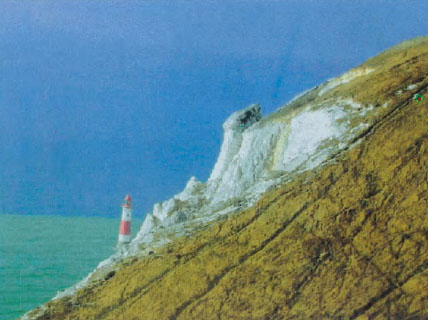
[caption id="LettersfromOurReaders_img1" align="aligncenter" width="428"]

COURTESY FRANKAND VERONICA PINCKARD
SPECTACULAR SCENES
HAVING RECENTLY RETURNED from a few days in the South of England, we were delighted to read Jim Hargan’s article on the South Downs Way (March 2004, page 34). As stated, it is an easy distance from Gatwick Airport. After renting a car, it was our very first “port of call.” We headed for the lovely village of Alfriston and after lunching there decided to find a B&B on the coast.
Imagine our good fortune on finding the Boathouse at Birling Gap. This grey clapboard old fisherman’s cottage was just what we hoped to find. The price was extremely reasonable and the owners just delightful. It was so close to the edge of the cliff that we could experience the sounds and smells of the sea as it rolled in.
At Birling Gap there is an iron staircase making for safe access to the beach from where we took stunning photos of the famous chalk cliffs at Seven Sisters. We walked this rather difficult beach composed of nearly 500-million-year-old flint encased in the white chalk.
Farther east we walked the clifftop again at Beachy Head to view the ever-constant erosion—a massive rock fall three years ago had caused the famous lighthouse to be moved out farther.
While we very much enjoyed Jim Hargan’s article, we wished he had included such spectacular scenes as our photos show.
Frank and Veronica Pinckard
Valencia, California
A CANTERBURY TALE
THE ARTICLE ABOUT BRITISH FILMS OF World War II (November, page 38) probably only scratched the surface. There must have been many more, which we in the U.S. rarely see, and the author should expand on the topic. Region-free, multi-format video players are now cheap enough to allow the collecting of British DVDs, but many films are unfamiliar and often the discs remain in release for only a short time. Some guidance would be helpful.
I recently discovered A Canterbury Tale, released in 1944. A war film without fighting, it concerns two soldiers and a “Land Girl,” whose incidental pilgrimage to Canterbury yields blessings for each. There are fascinating scenes showing blocks of buildings levelled by the Blitz, the Cathedral with its historic windows removed to a place of safety, plus a glimpse of life in a nearby village that includes a wheelwright’s shop.
What begins as an insubstantial mystery becomes an allegory of miracles. The perpetrator becomes the facilitator, or the instrument through which the miracles are delivered, and the mystery no longer matters. Even penance becomes unnecessary, as the central figure effectively vanishes in plain sight, through the miracle of grace. (Some say the closes his eyes at the relief of not being denounced, but I know better.) The result is not your usual wartime morale builder, but a transcendent view from which even war seems smaller. Critics of the day apparently missed the point and the film was not a success. Even now, viewers sometimes miss the transition from the basic storyline to the spiritual aspect.
I recently struck up a correspondence with one of the stars of A Canterbury Tale, Sergeant John Sweet of the U.S. Army. In his latest letter he explained that his ” backstage” view of the production prevented him from experiencing its emotional power. That is unfortunate, because his performance—in his only film—is sensitive and touching. The Cathedral itself symbolizes a benevolent, reassuring force that can restore and transform lives. I missed that when I was there and saw only a town full of tourists. A Canterbury Tale has opened my eyes, and my next visit will be a pilgrimage.
Richard Simonton
Geneva, Florida
AHEAD OF HER TIME?
IN HER EXCELLENT ARTICLE in the March 2004 issue, “Following Daniel Defoe across England’s South-West Coast” (page 44), Jennifer Dorn, after discussing Victorian author Anthony Trollope, refers to Jane Austen as “another Victorian novelist.” However, I would like to point out that Jane was not a Victorian novelist. She wrote in the late 1700s and early 1800s, and died in 1817, well before the Victorian period began in 1837.
Ann Slattery
Washington, DC
EDITOR’S NOTE: Here is where we’d print a rational explanation for this error, if indeed there.were any. Unfortunately, this is just a case of absentminded editors. Of course, the many (many) readers who pointed this out to us are right, jane, while perhaps a little ahead of her time, can by no stretch of the imagination be called “Victorian.” Our apologies for the mistake.





Comments